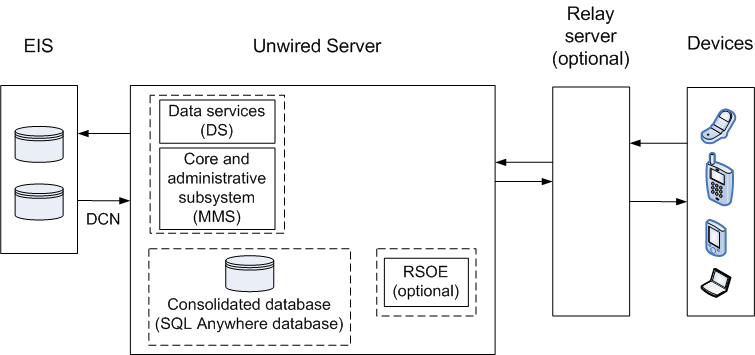Describes the replication-based synchronization (RBS) process flow, and options available for diagnosing problems at each step of the process.
Process flow
This diagram shows a logical view of replication-based synchronization communications between the enterprise information system (EIS), Sybase Unwired Platform components, and device clients. Relay server is included as an optional component.
RBS process flow

Troubleshooting options
This section describes the options available for diagnosing RBS processing flow problems.
Unwired Server – data services (DS):
- In Sybase Control Center, enable data services (DS) subsystem logging by setting its log level. The output is written in the server log.
- Review subsystem messages for information about getting data and sending transactions.
- For cache activities, you can enable monitoring on the package and then use Sybase Control Center to review cache statistics captured for the period monitoring is enabled.
Unwired Server – core and administrative subsystem (MMS):
- If you like to troubleshoot at the system-level (which will record all domains and packages activities), you can enable MMS logging by setting the log level in Sybase Control Center. The output is written in the server log.
- Select the desired application package, and enable monitoring. The captured data appears in Sybase Control Center. Use package-level logging to review data in the domain log.
- For low-level debugging and diagnostics, you may enable "Sync Tracing" for the package in Sybase Control Center. The output is written in the server log.
- For quick troubleshooting to locate system errors, you can check the package-level client log and MBO/Operation history in the Sybase Control Center.
- View the MBO/Operation history in Sybase Control Center for errors during back-end interaction with the EIS.
- On Unwired Server, review the errorlog.txt for any consolidated database system errors: <UnwiredPlatform_InstallDir\UnwiredPlatform\Servers\UnwiredServer\errorlog.txt.
Relay server – if used:
- Enable relay server tracing by setting verbosity to 1 or higher. You can do that by editing the rs.config file of your Relay Server and running the rshost utility. Check the System Administration topic on Relay Server Setup.
- Review the relay server log files. The logging for rshost.exe is directed to the myrshost.log file in the C:\temp directory.
- Check the IIS log files (windows\logfiles\W3SVC1 and HTTPERR). The IIS server log path is configurable from inetmgr from . The recommended location is C:\Inetpub\LogFiles.
On Unwired Server, check the SUP outbound enabler log for replication based synchronization entries: <UnwiredPlatform_InstallDir>\UnwiredPlatform\Servers \UnwiredServer\Logs\<SUPServerName>.RBS<PORT>RSOE<num>.log (for example, supqa01SUPServer1a.RBS2480RSOE1.log).
Device clients:
- Use the platform-specific client logging API (com.sybase.persistence.LogRecord in Java, and Sybase.Persistence.ILogRecord in C#) to capture log messages and upload them (Client Log) to Unwired Server. You can view these messages in the Sybase Control Center user interface